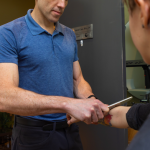Carpal Tunnel Symptoms, Syndrome
 Cause and treatment options
Cause and treatment options
The Median nerve (involved in Carpal Tunnel Syndrome) can get pinched, compressed or irritated from inflammatory (biochemical) factors ANYWHERE along the nerve path from the neck down to the wrist and hand, not just within the carpal tunnel (at wrist/hand).
In other words, a surgical intervention that attempts to release the carpal tunnel will NOT work if the nerve is entrapped elsewhere and will only provide temporary relief if the root cause is not determined such as hormone imbalances, provoking diet, inflammation, repetitive strain or a build-up of fibrosis/scar tissue.
Mechanism of Injury
- Nerves need space to slide and travel AND the space to heal (adequate blood flow).
- If this blood supply is compromised, the nerve will start to complain with pain, tingling, numbness, paresthesias (odd sensations).
- If aggravation of the nerve continues, more serious damage can occur to the nerve and lead to further complications such as muscle weakness and atrophy (and potentially permanent nerve damage).
Sources of Carpal Tunnel symptoms that are NOT due to a ‘small’ genetic compartment/tunnel.
- Compressions, restrictions or adhesions (scar tissue) in and around the tendons, fascia or muscles that surround the nerve.
- Tendon/muscle/fascial enlargement or restriction due to the swelling of the tendon or other soft tissues surrounding the nerve from overuse, tendinopathy, hormone changes or inflammation.
- With more persistent, recurrent or chronic versions of Carpal Tunnel Symptoms, this swelling is often due to fibrotic material (adhesions) that do not go away even if the swelling subsides.
- These adhesions are tiny forms of scar tissue (collagen haphazardly arranged) that take up space and either compress, restrict or stick to the nerve itself.
- Even though Carpal Tunnel Syndrome/Symptoms can be from the carpal tunnel enclosure itself (located at the base of hand/distal wrist), often the entrapment site is higher up in the arm or neck.
- These other entrapment sites that can cause or contribute to Carpal Tunnel Syndrome or Symptoms can be found in the neck, shoulder, elbow, forearm or wrist
- The can often be treated or released with soft tissue therapies such as Active Release Techniques (nerve entrapment). Even if the entrapment is at the Carpal Tunnel, soft tissue therapies and/or Laser can often create space and/or calm down the nerve to help fix the problem.
Treatment and Rehab
The treatment for Carpal Tunnel Syndrome/symptoms needs to be very specific to achieve relative movement between the nerve and these adjacent structures. Advanced knowledge of the anatomy is required to treat these conditions so that the ‘offending’ structure is held in place while the nerve is slides past it.
Once the entrapment site is identified, the goal of treatment is targeted to create a permanent release by creating space so symptoms resolve and more chronic or permanent nerve damage is prevented. As well, identifying the aggravating or causational factor is important. This way, we can remove or modify (and/or strengthen/stretch) any factors contributing to a recurrence.
Nerves do not like to be stretched.
- Rehab should include exercises that don’t pull the nerve from both ends. This is often referred to as Nerve Flossing.
- Nerve Flossing includes movements that move the nerve back and forth (like flossing your teeth) between muscles and other soft tissue structures in order to free up the nerve from these entrapments without tugging on the nerve from both ends.
- Median Nerve Flossing (for Carpal Tunnel Symptoms/Syndrome) can be a key factor during/after the treatment.
Treatments are severity and phase based
My treatments may include Active Release Techniques (scar tissue release and mobility), Class 3B or 4 laser (penetrates into the soft tissues to promote healing and reduce inflammation) and stretching and rehabilitative exercises.